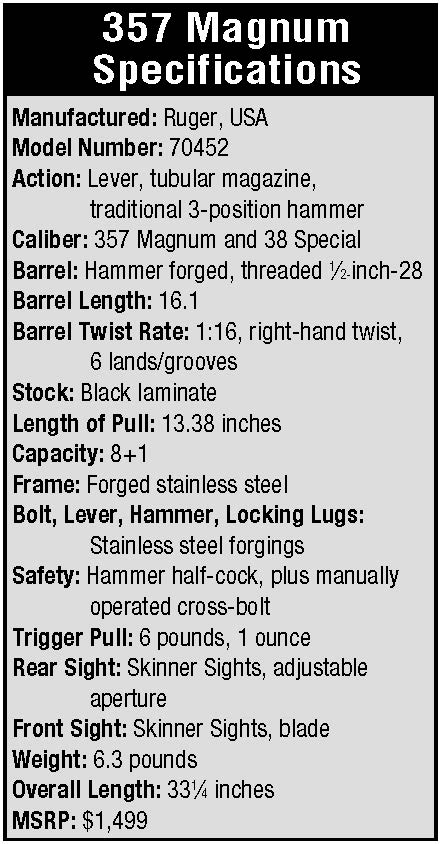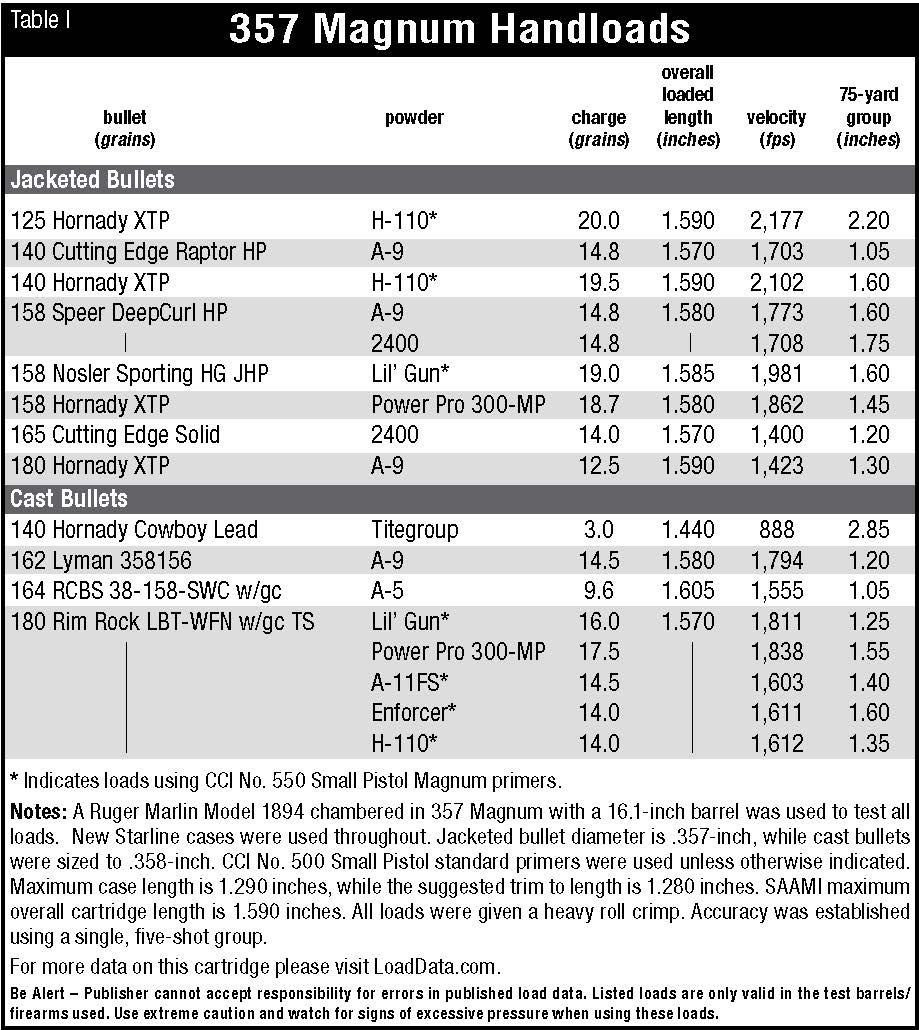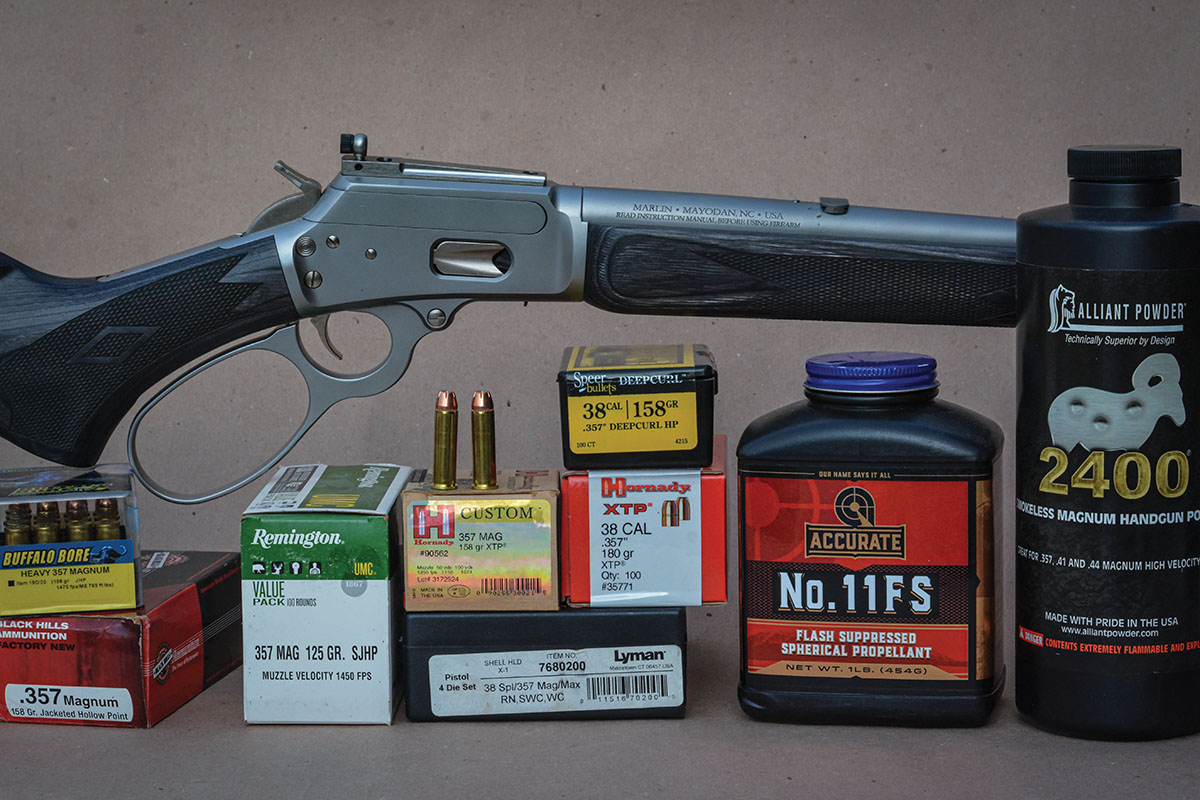
Marlin is offering the Model 1894 Trapper Carbine in 357 Magnum. It features stainless-steel construction, dark gray laminate stock and a 16.1-inch twist with a threaded barrel.
Marlin has been producing a variety of guns for 153 years, and during that time, it has weathered huge economic depressions, wars and many obstacles. However, let’s begin this story in July 2020 when Marlin’s parent company, Remington, declared bankruptcy. What is incredible is that Remington had been struggling with quality and finances for years. Marlin, however, was the company’s cash cow that was literally carrying the parent company financially. Ruger officials knew the value and potential of Marlin and their proven lever gun designs and purchased it lock, stock and barrel out of bankruptcy, which, in my opinion, was a match made in heaven!
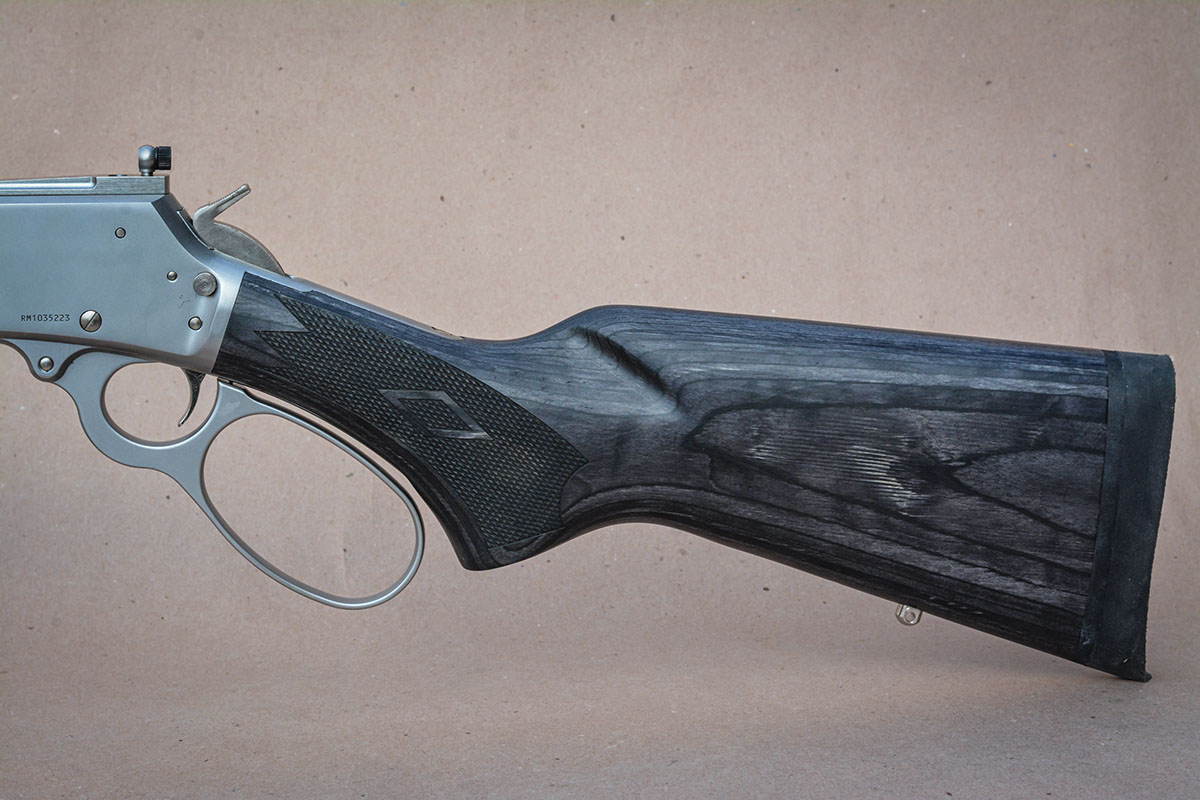
The gray laminate stock features a soft rubber recoil pad, pistol grip and oversized finger lever loop.
The road ahead was not easy, as the tooling that Remington had purchased to build Marlin rifles was not maintained during the bankruptcy period. In the humid Northeastern climate, it had rapidly deteriorated. Neither was that tooling conducive to the way that Ruger
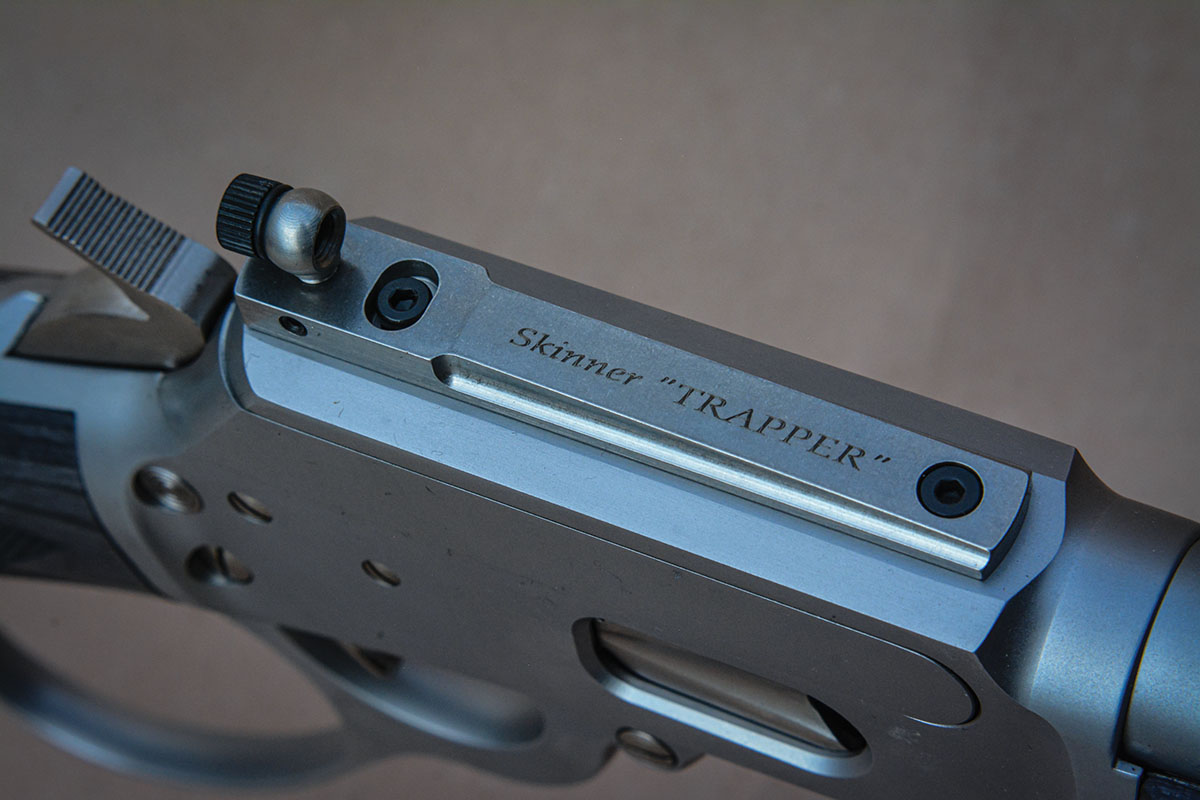
The new Marlin 1894 Trapper Carbine comes with a factory-installed Skinner “Trapper” aperture rear sight.
manufactures guns. Ruger quickly put their engineers to work to establish new blueprints through reverse engineering but also made small improvements that increased reliability. During this process, blueprints were often forwarded to me, seeking my opinion. I can state that Ruger engineers sought to make Marlin better than ever. (Incidentally, Remington also developed new blueprints to be compatible with CNC tooling in 2010/2011 when moving Marlin manufacturing from Connecticut to New York, but it took time to get the bugs worked out.) Ruger also established a new manufacturing methodology, etc., that has resulted in the highest quality control that we have seen from Marlin for many decades. This is not to say that the John Marlin or “JM” stamped guns are not good guns, as they are. But the new Ruger Marlin lever guns are held to tighter tolerances and display excellent machining.
The first Ruger Marlin lever gun to be produced was the Model 1895SBL chambered in 45-70 Government with early guns shipping in late 2021. Sales were huge and it took considerable time before guns were readily available on dealer’s shelves. In fact, demand was so high that scalpers were charging 2 or 3 times MSRP! But Ruger did it right and these guns worked flawlessly and were accurate.
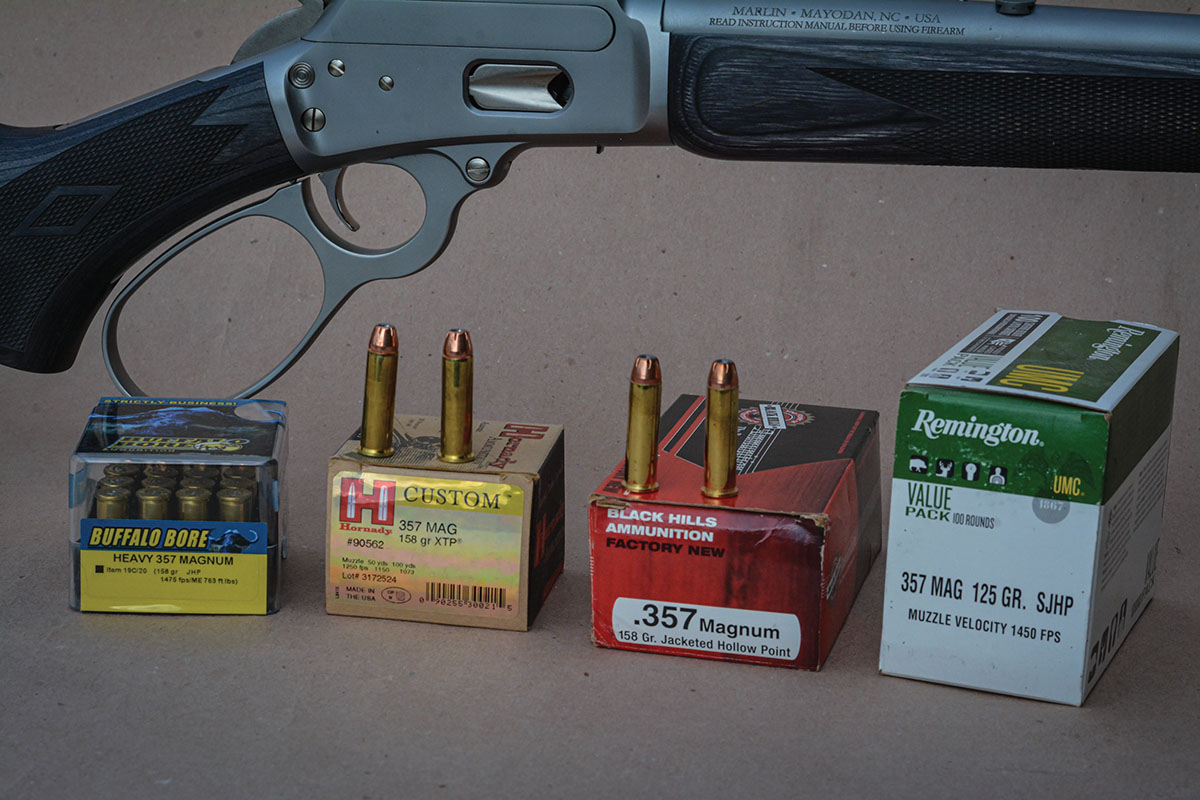
Several factory loads were tried that proved accurate.
Ruger ramped up production as fast as feasible, then introduced new variations of the Model 1895, followed by the Model 336 chambered in 30-30 Winchester. The highly anticipated Model 1894 Classic chambered in 44 Magnum finally appeared in 2023. This gun was finally fitted with a 1:20 inch barrel twist that allowed it to stabilize bullets up to 320 grains and even heavier. The accuracy of the new Ruger Marlin proved excellent. Once again, orders were huge and demand high and it took considerable time for these guns to become readily available.
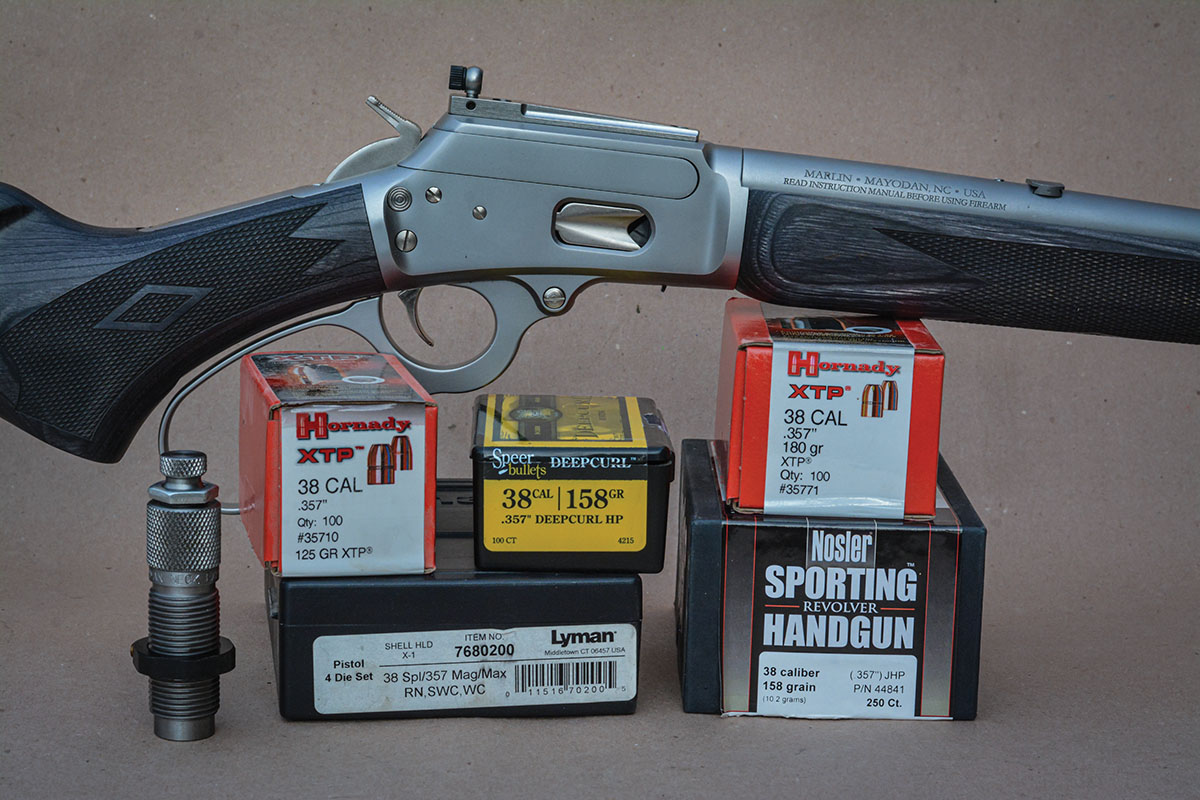
Lyman dies were used to develop handloading data.
Another highly anticipated caliber for the Model 1894 is the 357 Magnum, with a sample gun arriving in the popular Trapper version. In addition to being stainless steel, it sports a 16.1-inch threaded barrel with a protector, laminated stock and a large lever loop with a pistol grip design.
Personally speaking, I’m very fond of the Model 1894. Its action is compact, lightweight and handsome. It is really the same gun as the Marlin Model 1889, but it included a few small improvements when it became the Model 1894 a few years later. This was a truly modern design that is essentially the same design as the Model 1893 that evolved into the Models 93, 36, 336 and the original Model 1895, as well as the post-World War II Model 1895 (that is based on the 336 actions with round bolt, etc.). Due to slow sales of period cartridges such as the 25-20, 32-20, 38-40 and 44-40, the Model 1894 was discontinued during the Great Depression. However, with the growing popularity of the 44 Magnum, in 1969, Marlin reintroduced it, and then in 1979, it was first offered in 357 Magnum. In the years since, many additional calibers have been offered that have ranged from 22 WMR to the 45 Colt.
The design is simple, strong, rugged and reliable. Its closed action with solid top receiver keeps dirt and debris out, protects the action when subjected to harsh use, but also allows scope mounting, aperture sights, reflex sights, etc. to be installed. The side ejection tosses cases out (to the right) and is clear from the line of sight. Working the lever about halfway and removing the finger lever pivot cross-screw, the lever can be removed and the bolt pulled out to the rear for easy cleaning and lubrication of working parts. This also allows breech access to the barrel for cleaning, which helps to prevent damage to the crown that often happens with other lever action designs that are generally cleaned from the muzzle. For guns that are often exposed to the elements or are fired in volume, full disassembly is necessary to clean and lubricate all working parts. This procedure is simple and easy and, with minor instruction, can be accomplished by a hobbyist.
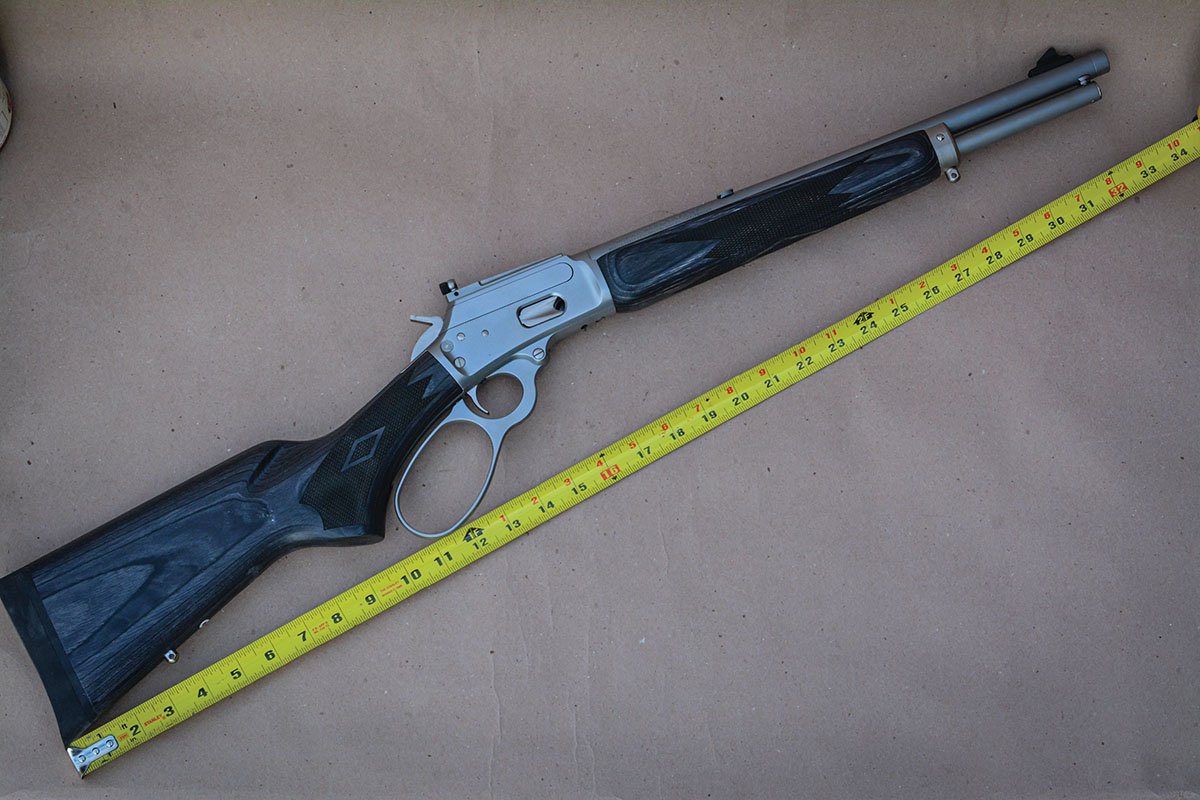
The Marlin Model 1894 Trapper Carbine is just 33.25 inches long and weighs 6.3 pounds.
Regardless of ownership, Marlin has always used forgings for their major component parts, even on price point economy guns fitted with hardwood stocks, etc. Forgings compress and rearrange steel molecules to increase strength and durability. This has been a significant advantage over competition that succumbed to stamped parts (such as the post ’64 Winchester rifles) that are notably less durable.
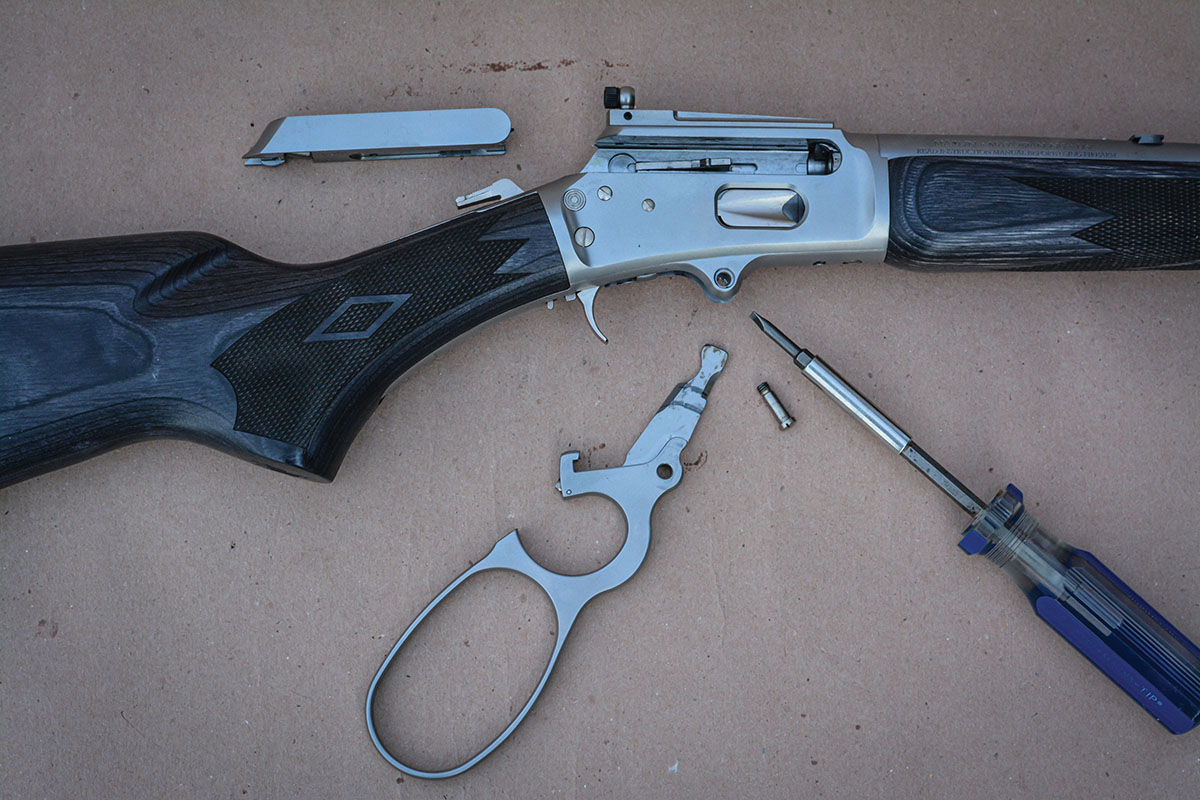
The bolt can be removed in seconds for cleaning and lubrication and also allows barrel breech access.
Back to our current Model 1894 Trapper. It comes with a factory-installed stainless steel Skinner Trapper aperture rear sight and blade-style front with a ramped, white face. In addition to the Skinner rear sight being fully adjustable for windage and elevation, rugged and lightweight, it has a ghost ring aperture that measures .200-inch, which is ideal for low light conditions. However, the ghost ring is threaded and readily accepts interchangeable apertures that measure
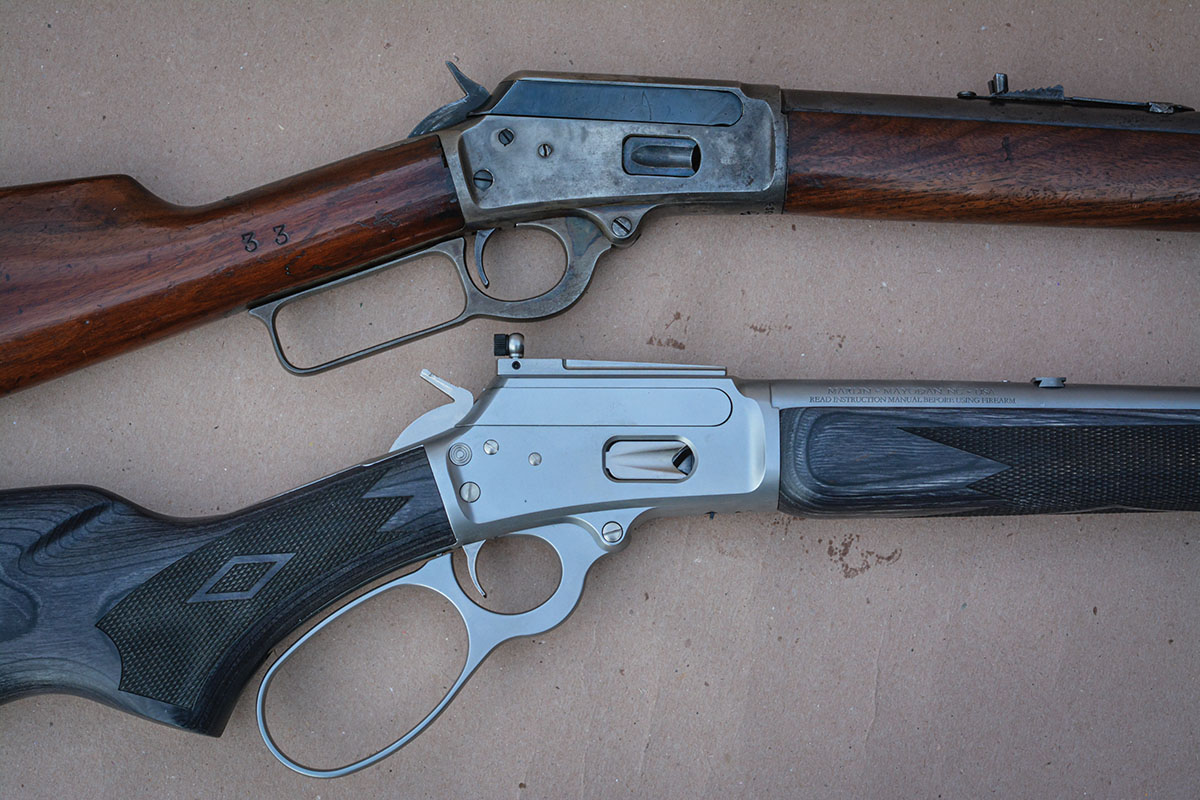
The original Marlin Model 1894 (top) chambered in 44-40 Winchester shares the same basic action design as the current Ruger Marlin Model 1894 (bottom) chambered in 357 Magnum but boasts of modern stock materials, threaded barrel, etc.
.040, .070, .125 and .155-inch. This is a wonderful feature, as the smaller apertures allow more precise sighting under normal lighting conditions. Incidentally, apertures can be interchanged without tools in just a few seconds. The new Marlin comes with one extra aperture with a .155-inch hole size, while additional ones can be ordered directly at
www.skinnersights.com.
The 1894 Trapper retains the traditional three hammer positions including a half-cock (technically a quarter-cock) safety notch. And there is a manual cross-bolt (that first appeared in 1983) for additional safety. The gray laminated stock is checkered and features a soft rubber recoil pad. Out-of-the-box, the action works smoothly and has that new gun feel. After firing several hundred rounds through the Marlin, it naturally smoothed even more. The magazine capacity is 8 rounds, and the overall rifle length is 33.25 inches, resulting in a short, light and fast-handling carbine.
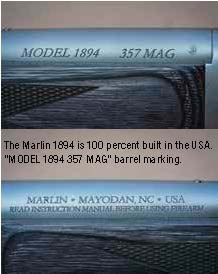
My only real complaint is the trigger pull. While it breaks clean, it is too heavy at just over 6 pounds. Ruger is offering bolt rifles with much lighter pulls right out-of-the-box, so I am encouraging them to consider dropping the pull weight of all lever guns to around 3 pounds. One feature that I have discussed with Eric Lundgren, overseer of Marlin operations, is to offer guns with two-finger lever loop sizes. Personally, I prefer more traditional finger lever sizes; however, the larger loops are popular. My suggestion is that rifles could be ordered with an extra lever as an option. A straight grip version would also be a welcome option. Until current demand subsides, such variants are unlikely to appear soon.
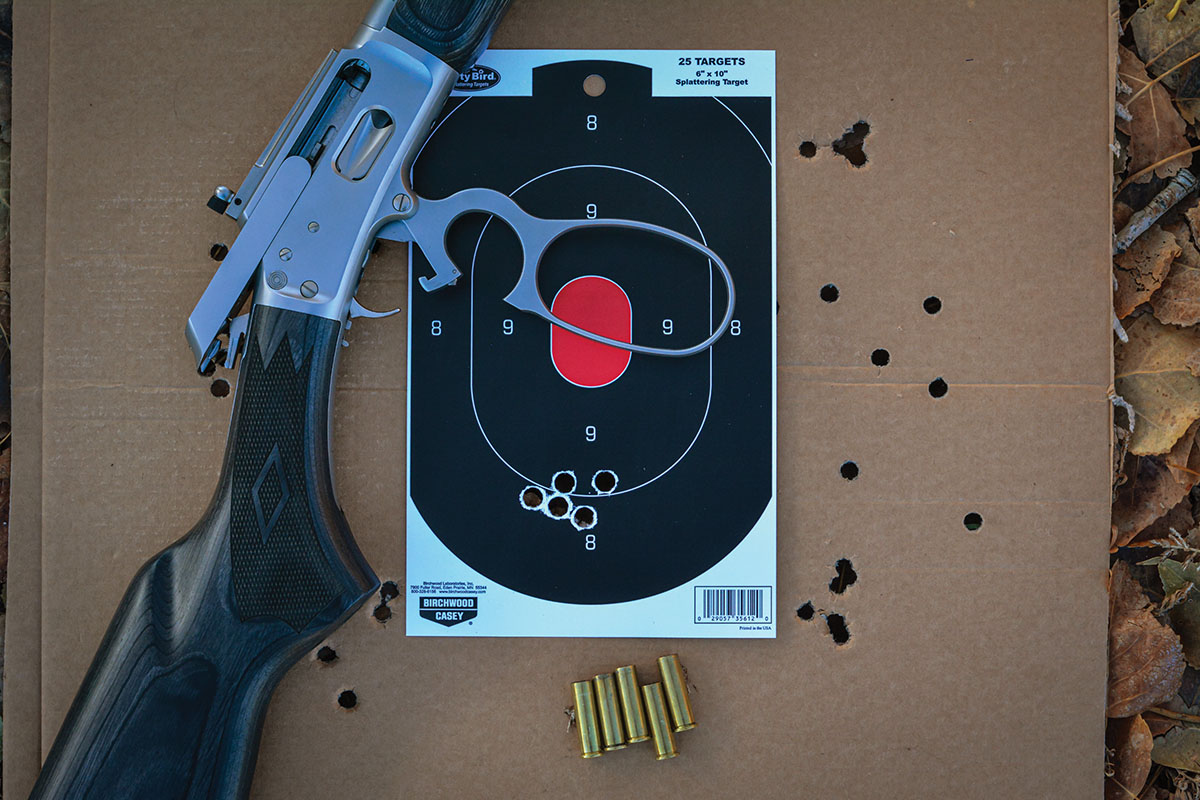
Accuracy testing was conducted at 75 yards, and the new Ruger Marlin 357 Magnum proved accurate with a variety of loads containing both jacketed and cast bullets.
The 357 Magnum is a truly great sixgun cartridge, but many shooters will only find the 1894 interesting if they have a handgun of the same caliber. However, that’s a mistake! The 357 offers a very unique blend of surprising power, modest recoil, economy, versatility and other virtues that allow it to stand on its own merit when fired from a rifle or carbine. With the threaded barrel and the option to install a suppressor, the 357 can be handloaded to subsonic velocities for super quiet firing.
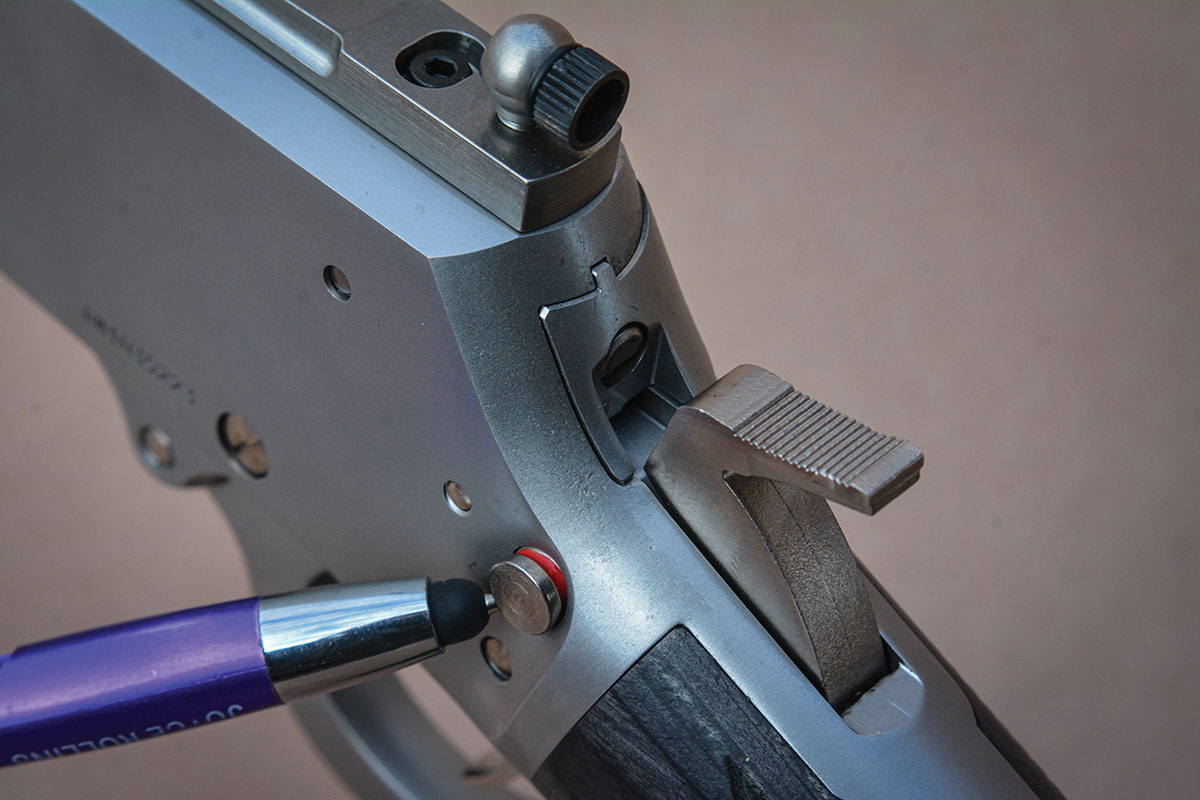
The Model 1894 features traditional half-cock safety and cross-bolt safety.
I have been using 357 Magnum carbines and rifles since the 1970s and have taken a variety of game, including mule deer, whitetail deer and black bear. Simply stated, they offer much greater terminal performance than their paper ballistics suggest. Most 158-grain factory loads will reach 1,700 to 1,900 feet per second (fps) from rifles and carbines, while 125-grain bullets usually reach nearly 2,100 fps. For deeper penetration on big game, various 160- to 180-grain cast bullets can reach 1,800 fps and will easily shoot through elk on broadside shots.
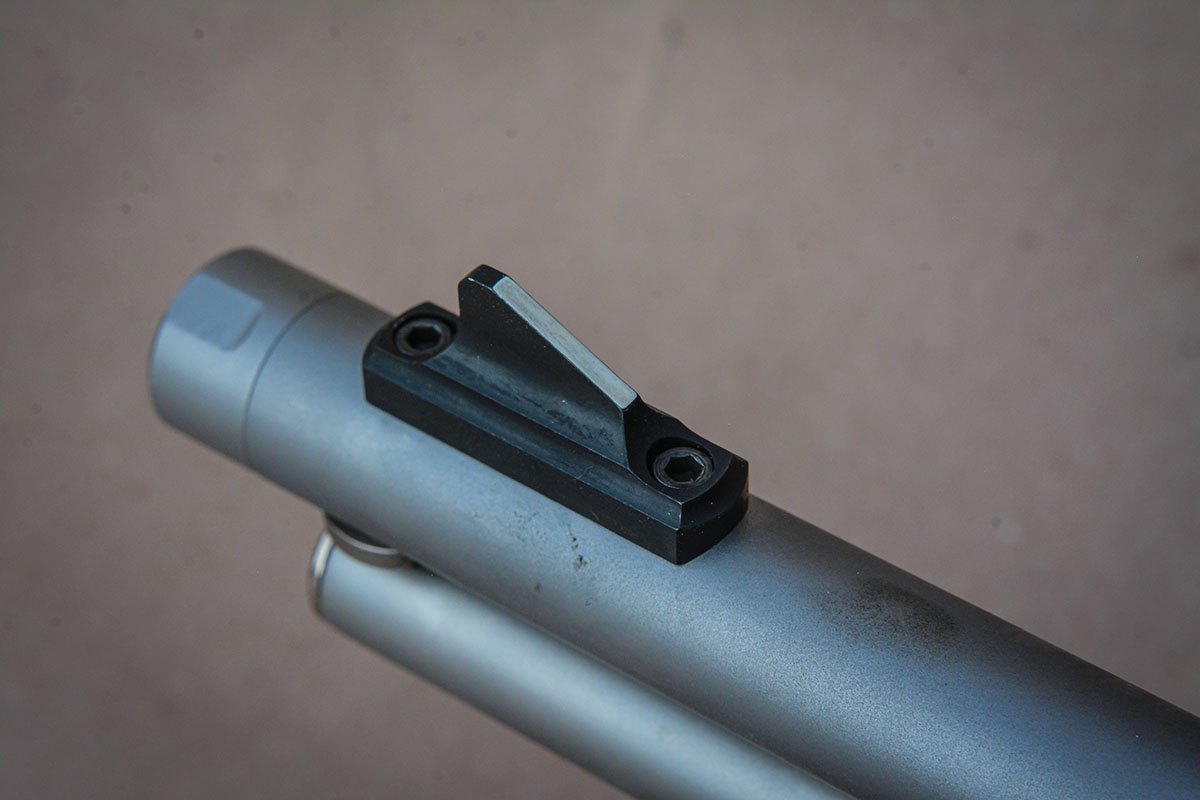
The front sight is a Skinner Sights blade with a white face.
While a .357-inch caliber is not really a big bore, it is nonetheless big enough that it delivers a significant shock to game. Most JHP-style bullets are designed to expand at sixgun velocities, but when increased by 500 or 600 fps from a rifle barrel, they expand rapidly and deliver significant wound channels. Expansion is reliable at any reasonable distance that the cartridge will be used. I have written various articles (with much greater detail than is mentioned here), and many readers have responded with praises of their field experiences that are similar to mine. One reader from Africa has used a 357 carbine (naturally with deep penetrating bullets) on most plains game, including multiple eland that he estimated at 1,500 pounds, with impressive results. The real key is to match the bullet to the game and not ask this little cartridge to perform at longer distances.
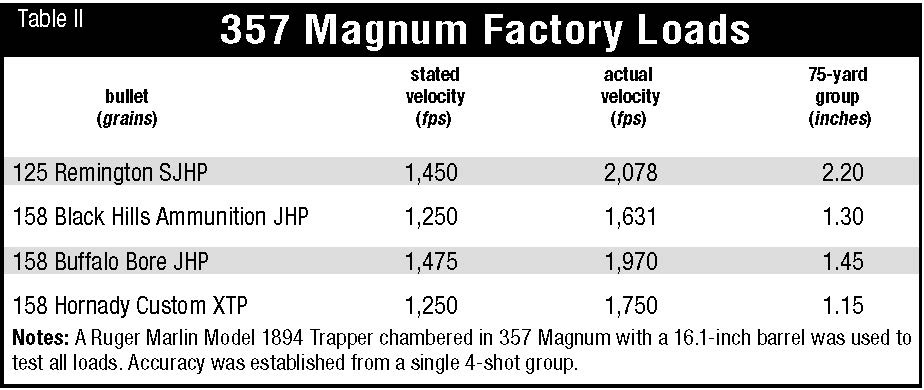
Incidentally, select 158-grain factory and handloads will reach 2,000 fps from a 20-inch barrel (Buffalo Bore), which is very close to duplicating the 30-30 Winchester that generally pushes a 150-grain bullet at 2,150 to 2,200 fps from carbines with 20-inch barrels. However, the 357 offers notably longer case life, produces less recoil and muzzle report, is housed in a shorter action, costs less per round and can be fired in sixguns!
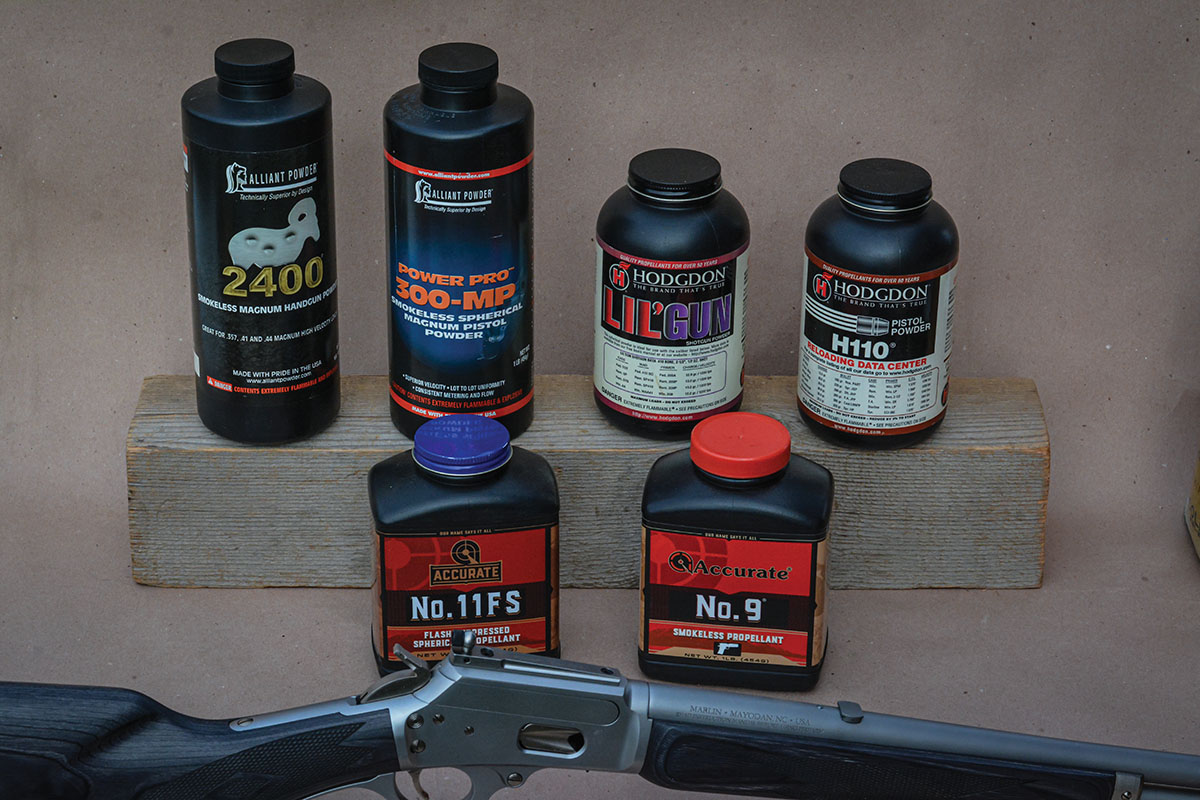
Slow-burning magnum revolver powders generally offer the highest velocities in the 357 Magnum.
Around 150 rounds were fired through the new Marlin before checking accuracy. Feeding, firing and ejection of empty cases was flawless. It should be noted that in addition to feeding JHP and round nose flat point bullets without a hitch, it also fed popular SWC cast bullets such as the widely popular Lyman Thompson mould No. 358156 and the RCBS 38-158-SWC that was seated .015-inch longer than SAAMI specifications at 1.605 inches. From a bench with sandbag rests groups at 75 yards regularly hovered around 1 to 11⁄2-inches for both 4-shot (factory loads) and 5-shot groups (handloads). I was very pleased with the accuracy that the new Marlin exhibited.
As can be seen in the accompanying chart, notable factory loads include the Buffalo Bore 158-grain JHP that reached 1,970 fps and grouped into 1.45-inches at 75-yards. The Hornady Custom 158-grain XTP reached 1,750 fps and was the most accurate factory load with a 1.15-inch group.
Moving on to handloads where the carbine was tested to a much greater extent, both cast and jacketed bullets gave excellent accuracy from the cold hammer forged barrel with 6 lands/groove and 1:16 inch twist. One notable load included the 140-grain Cutting Edge Raptor HP pushed to 1,703 fps using 14.8 grains of Accurate No. 9 powder that grouped into 1.05 inches for 5 shots. A cast bullet example includes the old-style RCBS mould 38-158-SWC with gas check at 164-grains. Pushed to 1,555 fps using 9.6 grains of Accurate No. 5 powder, it placed 5 shots into the same group size of 1.05 inches! A couple of loads for big game include the 180-grain Rim Rock LBT-WFN with gas check bullet that reached over 1,800 fps using 16.0 grains of Hodgdon Lil’Gun or 17.5 grains of Alliant Power Pro 300-MP powders. Groups hovered between 11⁄4 and 11⁄2-inches.
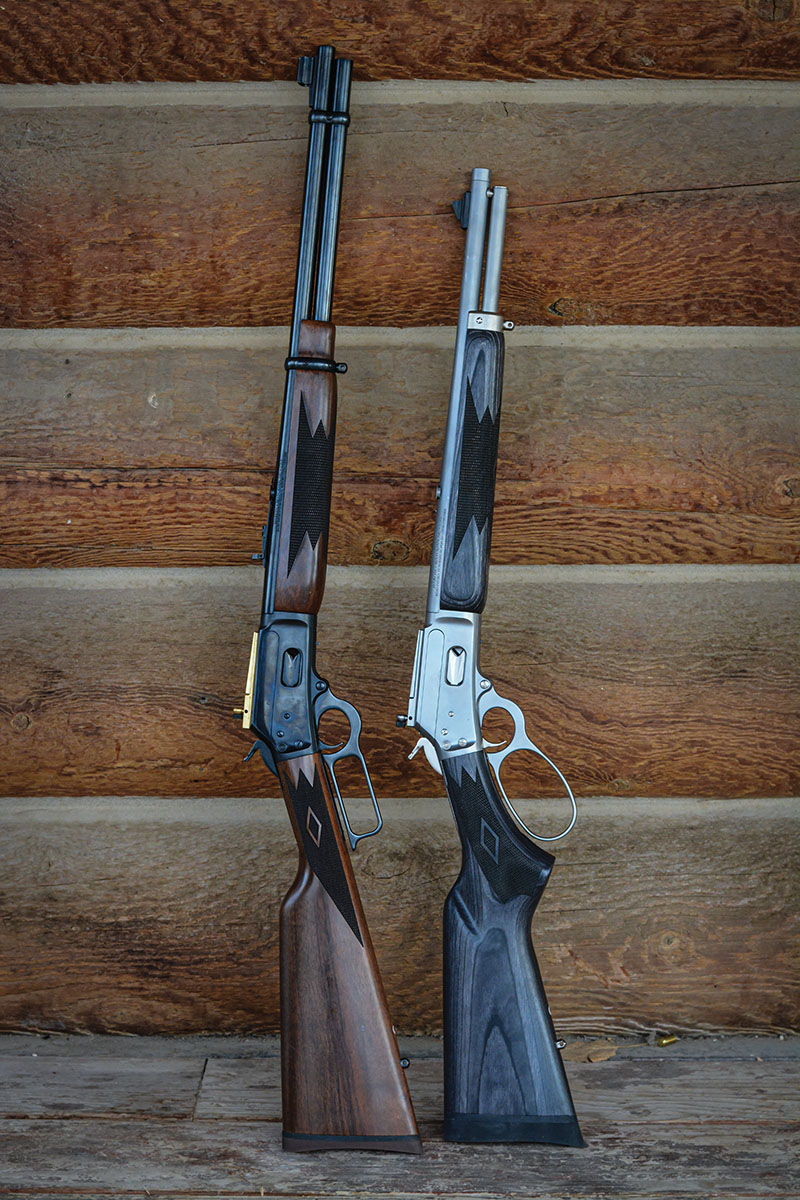
Marlin first introduced the Model 1894 with the Classic version chambered in 44 Magnum (left) but it is now offered in the Trapper Carbine stainless steel chambered in 357 Magnum (right).
Again, Ruger has brought Marlin back from the grave and is offering a top-quality product. Many more models are in the works, including the popular Cowboy variants, which have a huge following among shooters who just enjoy traditional blue steel with walnut stock. In addition to the octagon barrel, it would be nice to see the Cowboy version offered with a round barrel, just like the originals. The Trapper Carbine worked flawlessly, is accurate and is fun to shoot. If you have not tried a 357 Magnum carbine, I’ll bet that you won’t be disappointed.













